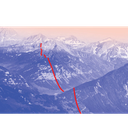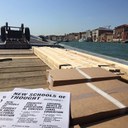Das Forschungsprojekt NEST untersucht Tendenzen im Kontext der akademischen Homogenisierung innerhalb der Europäischen Architekturausbildung. Es definiert New Schools of Thought (neue Denkschulen) als eine Reihe von Ideen und Meinungen über neue Methoden zur Wissensgenerierung sowie neuen Formen des Wissenstransfers, die eine Gruppe von Personen, die in Architektur und Raumplanung wirken, über Architekturausbildung teilen.
Obwohl ihre wachsende Präsenz seit den 1980er Jahren zu beobachten ist, gibt es eine Wissenslücke betreffend den Faktoren und Tendenzen, die Denkschulen beeinflussen und charakterisieren.
Seit dem späten 20. Jahrhundert erfährt die Architekturausbildung eine Transformation, bei welcher Schlüsselfaktoren wie bspw. neue politische Regulierungen, die Internationalisierung und die Digitalisierung eine Rolle spielen. Dies hat dazu geführt, dass Architekturinstitutionen neue Wege suchen, sich durch neu definierte Inhalte, Methoden der Wissensgenerierung und -transfer und Verschiebungen in der Organisationsstruktur von der Masse zu unterscheiden. Nichtsdestotrotz sind Schulen nicht länger die einzigen privilegierten Orte des Denkens. Es entwickeln sich neue Felder der Wissensproduktion und –reflexion, die neue Typen von Denkschulen hervorrufen.
Ziel von NEST ist es, neuen Denkschulen zu identifizieren, deren inhärente Eigenschaften zu erkennen und somit Tendenzen innerhalb der Architekturausbildung (von Vor-, Aus- und Weiterbildung) abzuleiten.
Die Erkenntnisse sollen einerseits einen Beitrag zum zeitgenössischen akademischen Diskurs in der Architektur liefern und andererseits die Voraussetzungen für die Entstehung von Denkschulen aufzeigen.
NEST wird in Zusammenarbeit mit den folgenden Forschungspartnern durchgeführt: dem Institut für Architektur und Raumentwicklung der Universität Liechtenstein, der Architectural Association School of Architecture in London (AA), dem Institut für Kunst- und Architekturgeschichte der Akademie der bildenden Künste Wien, der Fakultät Design Sciences der Universität Antwerpen und der Universität Umeå School of Architecture.
Publications
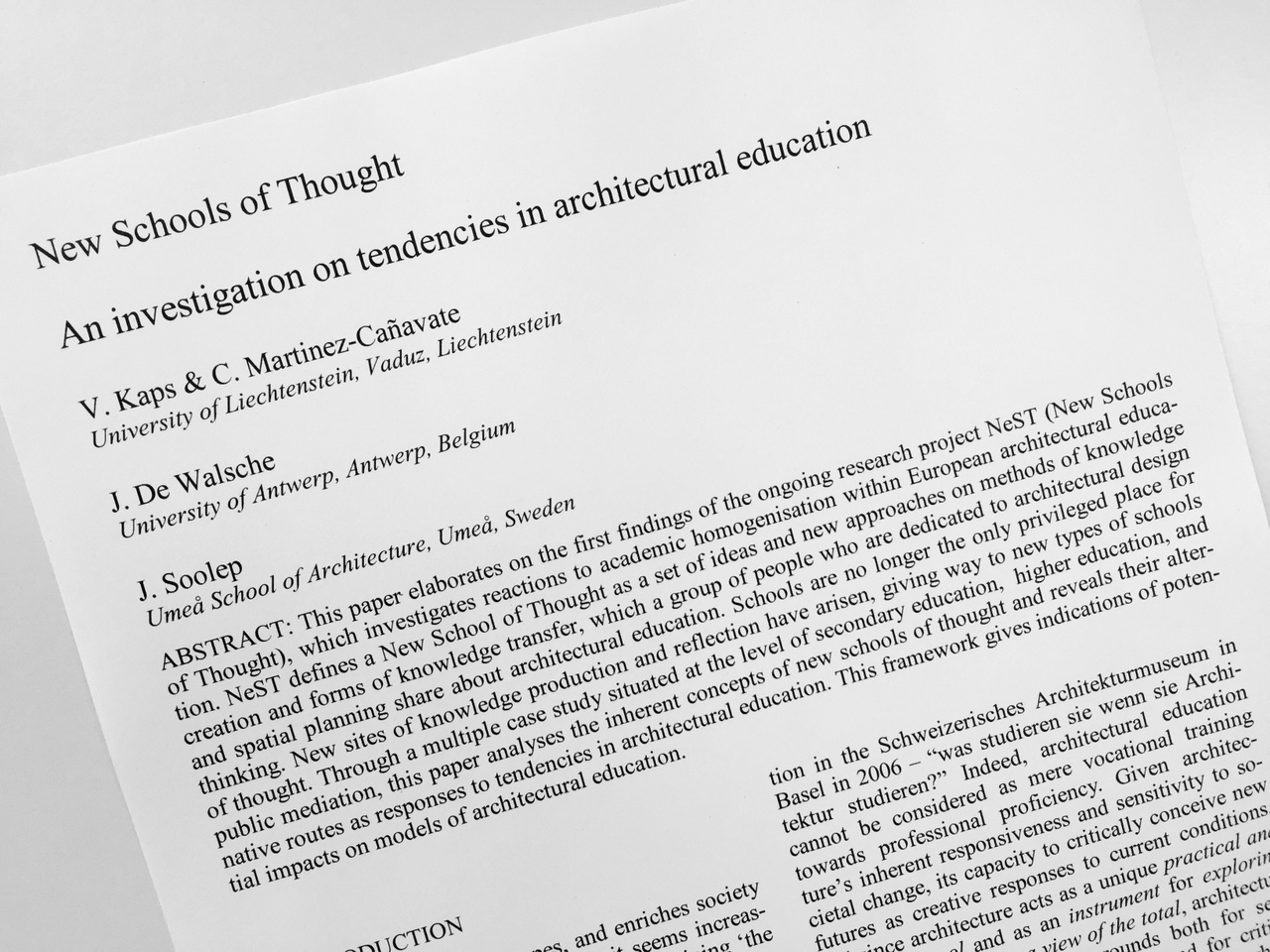 New Schools of Thought
New Schools of Thought
An investigation on tendencies in architectural education
by Vera Kaps, Celina Martinez-Cañavate, Johan De Walsche, Jüri Soolep
Published in: M. J. Rodrigues, C. da Costa, F. Roseta, J. Pestana Lages, S.a Couceiro da Costa (2017): Architectural Research Addressing Societal Challenges. Lisbon: CRC Press.
This paper elaborates on the first findings of the ongoing research project NeST (New Schools of Thought), which investigates reactions to academic homogenisation within European architectural education. NeST defines a New School of Thought as a set of ideas and new approaches on methods of knowledge creation and forms of knowledge transfer, which a group of people who are dedicated to architectural design and spatial planning share about architectural education. Schools are no longer the only privileged place for thinking. New sites of knowledge production and reflection have arisen, giving way to new types of schools of thought. Through a multiple case study situated at the level of secondary education, higher education, and public mediation, this paper analyses the inherent concepts of new schools of thought and reveals their alternative routes as responses to tendencies in architectural education. This framework gives indications of potential impacts on models of architectural education. NewSchoolsofThought_KapsMartinezDeWalscheSoolep.pdf (0.1 MB)
NewSchoolsofThought_KapsMartinezDeWalscheSoolep.pdf (0.1 MB) 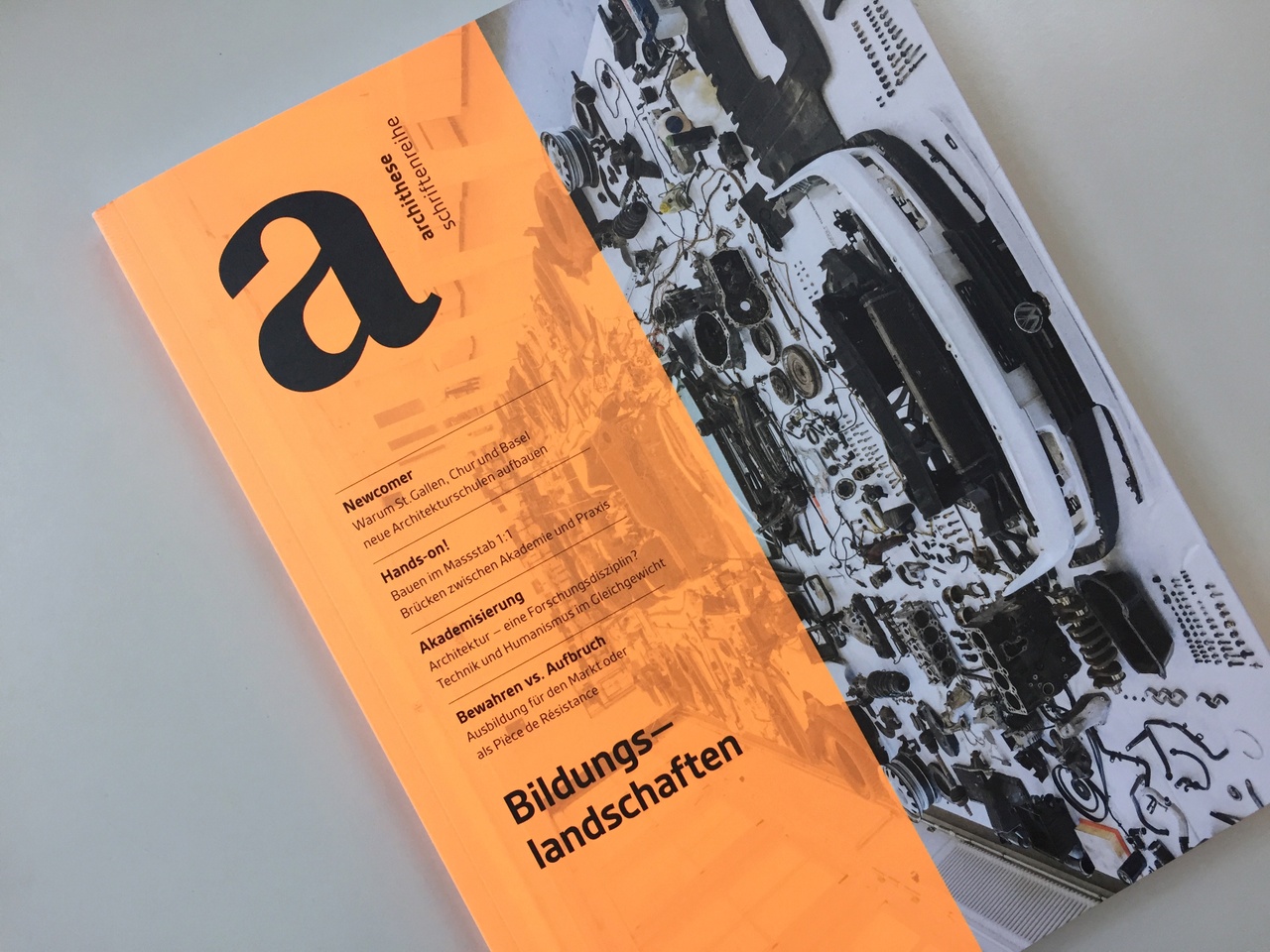
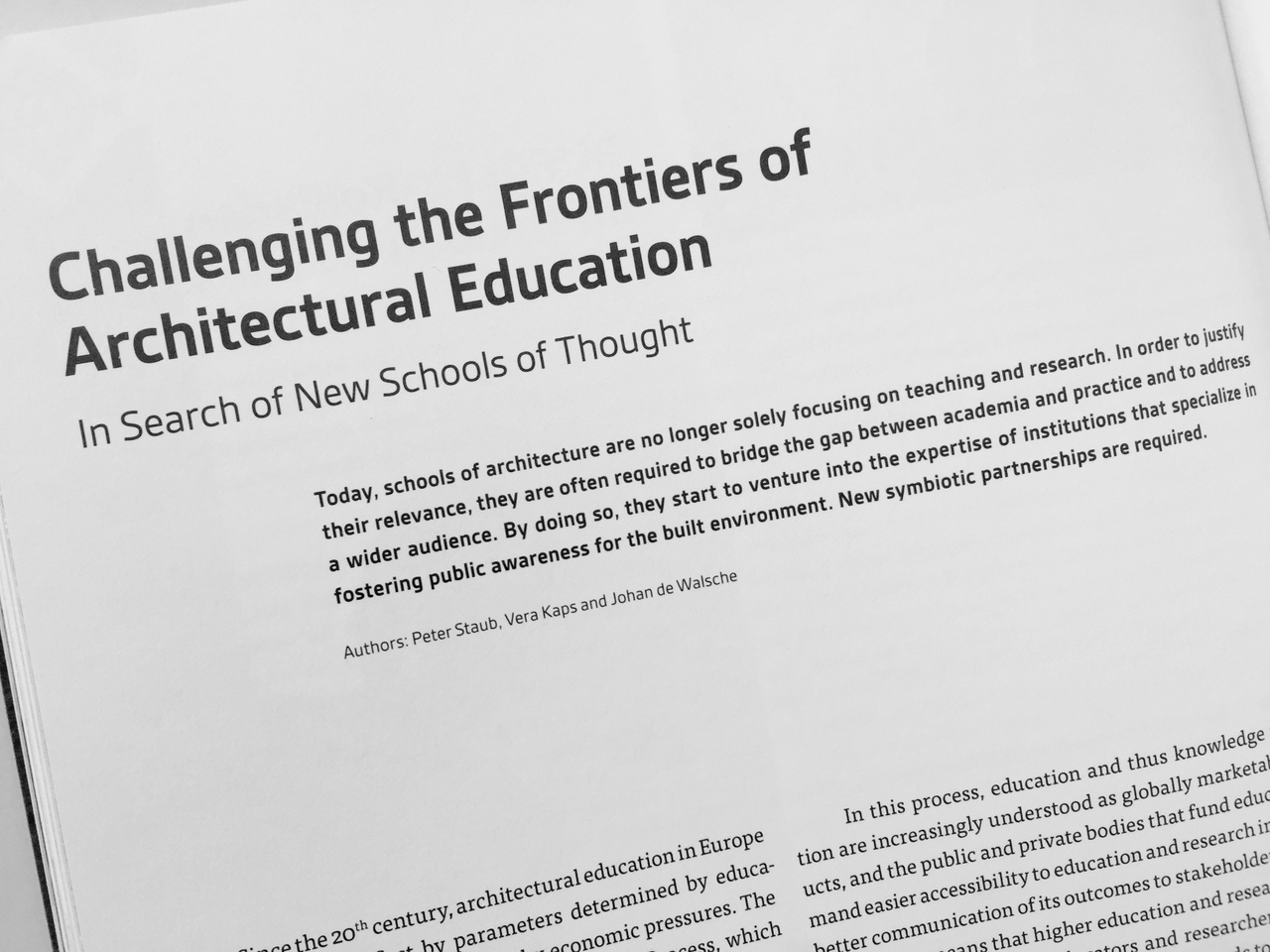 Challenging the frontiers of architectural education
Challenging the frontiers of architectural education
by Peter Staub, Vera Kaps and Johan De Walsche
Today, schools of architecture are no longer solely focusing on teaching and research. In order to justify their relevance, they are often required to bridge the gap between academia and practice and to address a wider audience. By doing so, they start to venture into the expertise of institutions specializing in fostering public awareness for the built environment. New symbiotic partnerships are required.
New Schools of Thought
Challenging the frontiers of architectural education
Edited by Peter Staub, Vera Kaps and Georgia Papathanasiou
Since the late twentieth century, architectural education in Europe has been reshaped by key factors such as new policy regulations, internationalisation and digitalisation. Given these circumstances, schools of architecture have been seeking ways to differentiate themselves, whether through content in research and teaching, methods of knowledge creation and transfer, or shifts in their organisational structures. In parallel, new, alternative sites of knowledge production and reflection upon architecture have arisen that successfully bridge the gap between academia and practice. Their ability to attract a wider audience through a much more public profile brings into question possible symbiotic collaborations and the emergence of new schools of thought within the expanding
field of architectural education.
This publication provides an insight into the ongoing research project “New Schools of Thought” (NeST). It investigates and identifies current contexts, possible tendencies and reveals teaching practices and alternative educational models. It does not intend to offer conclusions and solutions but to highlight trends, personal discoveries and observations of the status quo. Just like the perpetually evolving NEW in “New Schools of Thought”, it is a mere snap-shot in time, a Zeitschrift in its true sense.
Download: University-of-Liechtenstein_New-Schools-of-Thought_Biennale-2016.pdf (7.2 MB)
New Schools of Thought – Augmenting the field of architectural education
by Vera Kaps and Peter Staub
Publisher : Triest Verlag
Since the late 20th Century, political regulations, internationalisation and the rapid digitalisation are only a few factors that have significantly transformed the environments within which European institutions of architectural education operate. In the process of having to adapt and adhere to such changes, architectural education strives to develop innovative didactic, programmatic or spatial models that are distinguishable. Through 18 cases, four of which are portrayed in detail, this book highlights tendencies in architectural education beyond academia and reveals the interdependence between the educational model and its spatial disposition. This process has brought to the fore institutions and initiatives that are not restricted by the limitations of academia and include schools working with children and youths, research consortia assembled by academic and professional partners or independent public platforms of architectural mediation.
Events
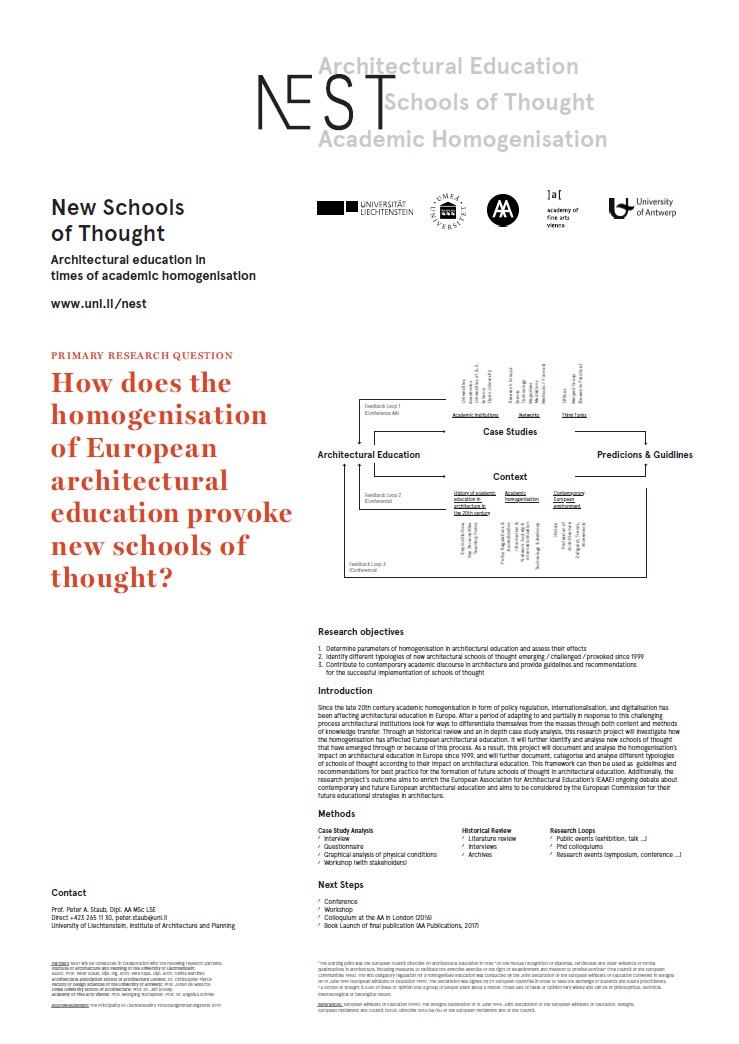 EAAE Annual Conference on Architectural Education towards 2030
EAAE Annual Conference on Architectural Education towards 2030
27.-30. August 2015 in Milan, Italy
The EAAE annual Conference will be held in Milano in conjunction with EXPO 2015 beginning the 27th of August with a celebration of Le Corbusier's work, exactly 50 years after his death.
This anniversary celebration is an opportunity to present the important and urgent issues concerning the transformation of cities, building and territories within Europe today. We are in a particular period of reflection where our contemporary history of the past half century is informing our present and future strategies in architectural education.
The meeting EAAE presents a platform to share a common reflection and an open discussion on the experiences carried out so far in schools and on the possible developments of the architectural profession, also affecting these. We will particularly focus on their relevance to the new Professional Qualifications Directive along with the duration of architectural programs of study. (from www.eaaemilano2015.polimi.it)
Prof. Peter Staub presented the research project NeST at EAAE 2015 in Milano. NEST_Poster.pdf (0.1 MB)
NEST_Poster.pdf (0.1 MB)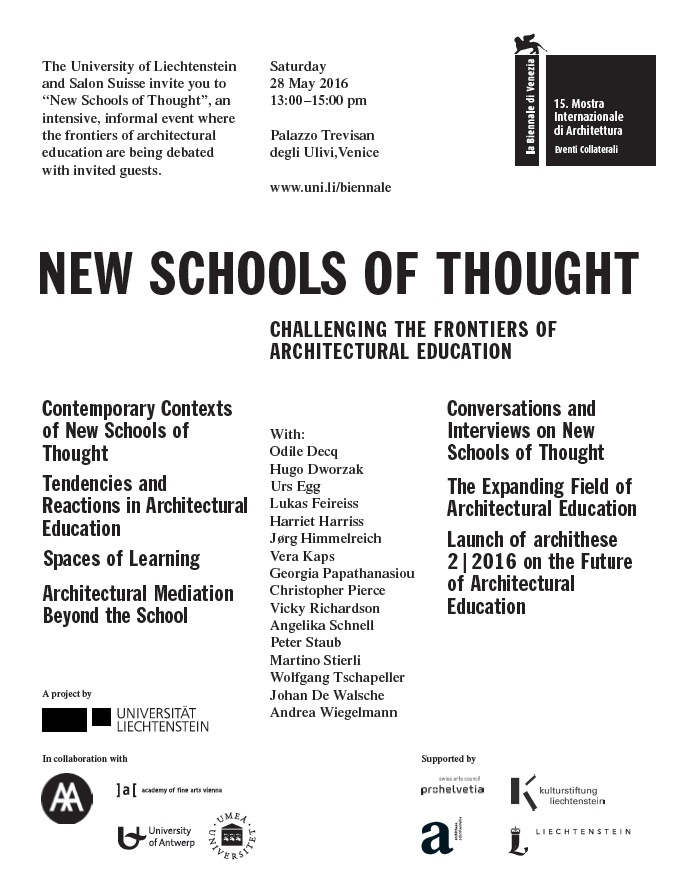 14th International Architecture Biennale di Venezia on Reporting from the Front
14th International Architecture Biennale di Venezia on Reporting from the Front
28. May 2016 in Venice, Italy
As special guests of the collateral event “Salon Suisse”, organised by the Swiss Arts Council Pro Helvetia, “New Schools of Thought” was an intensive, informal event challenging the frontiers of architectural education and mediation. Through a series of one-to-one conversations with experts, new tendencies emerging from the first findings of the international research project NEST conducted at the University of Liechtenstein were being discussed. Speakers included Odile Decq, architect and Dean of Confluence Institute for Innovation and Creative Strategies in Architecture in Lyon, Martino Stierli, the Philip Johnson Chief Curator of Architecture and Design at The Museum of Modern Art in New York, Harriet Harriss, Senior Lecturer at the Royal College of Art in London and Lukas Feireiss, curator and writer from Berlin. NewSchoolsOfThought_LaBiennale_2016.pdf (0.4 MB)
NewSchoolsOfThought_LaBiennale_2016.pdf (0.4 MB) 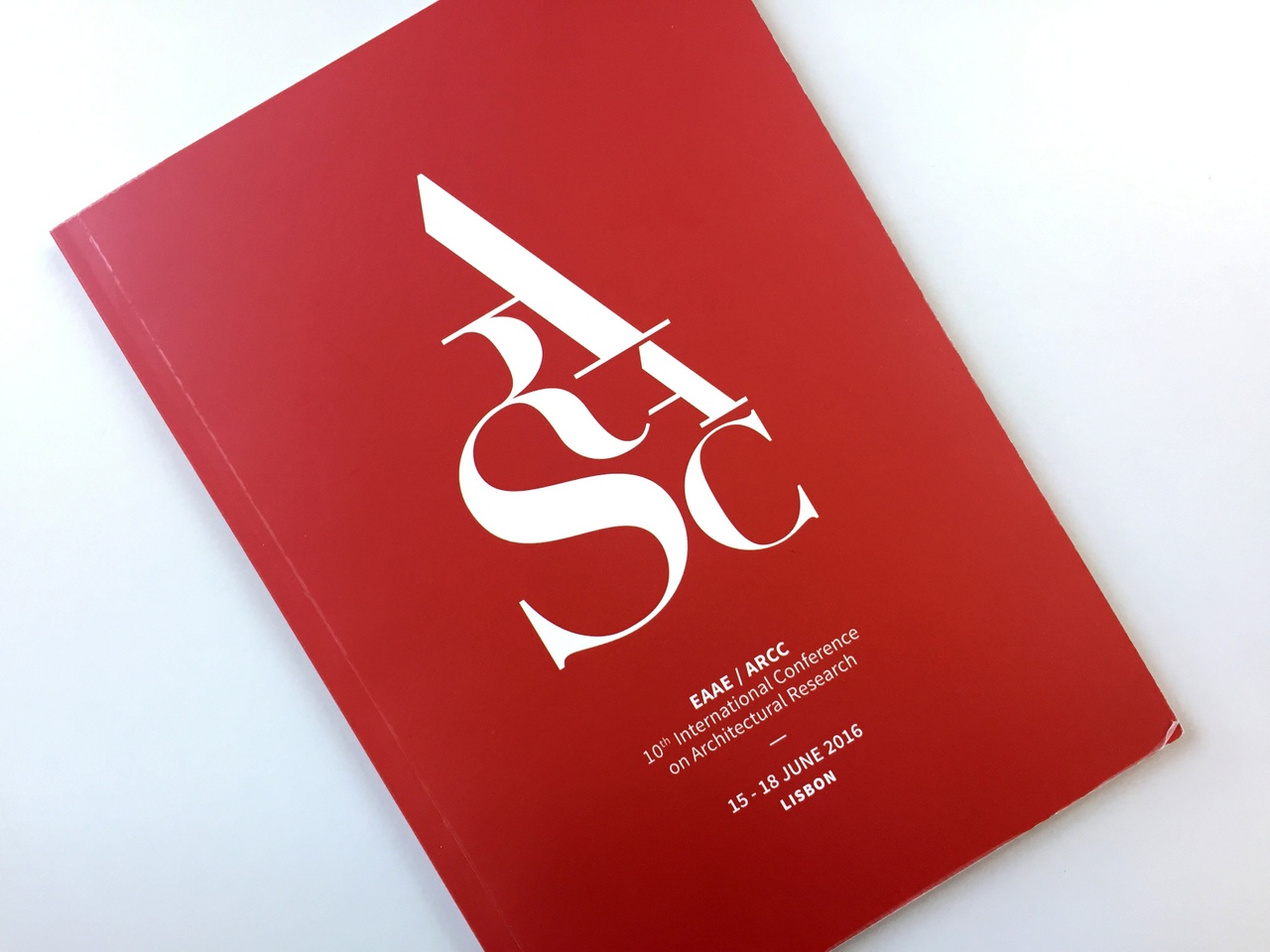
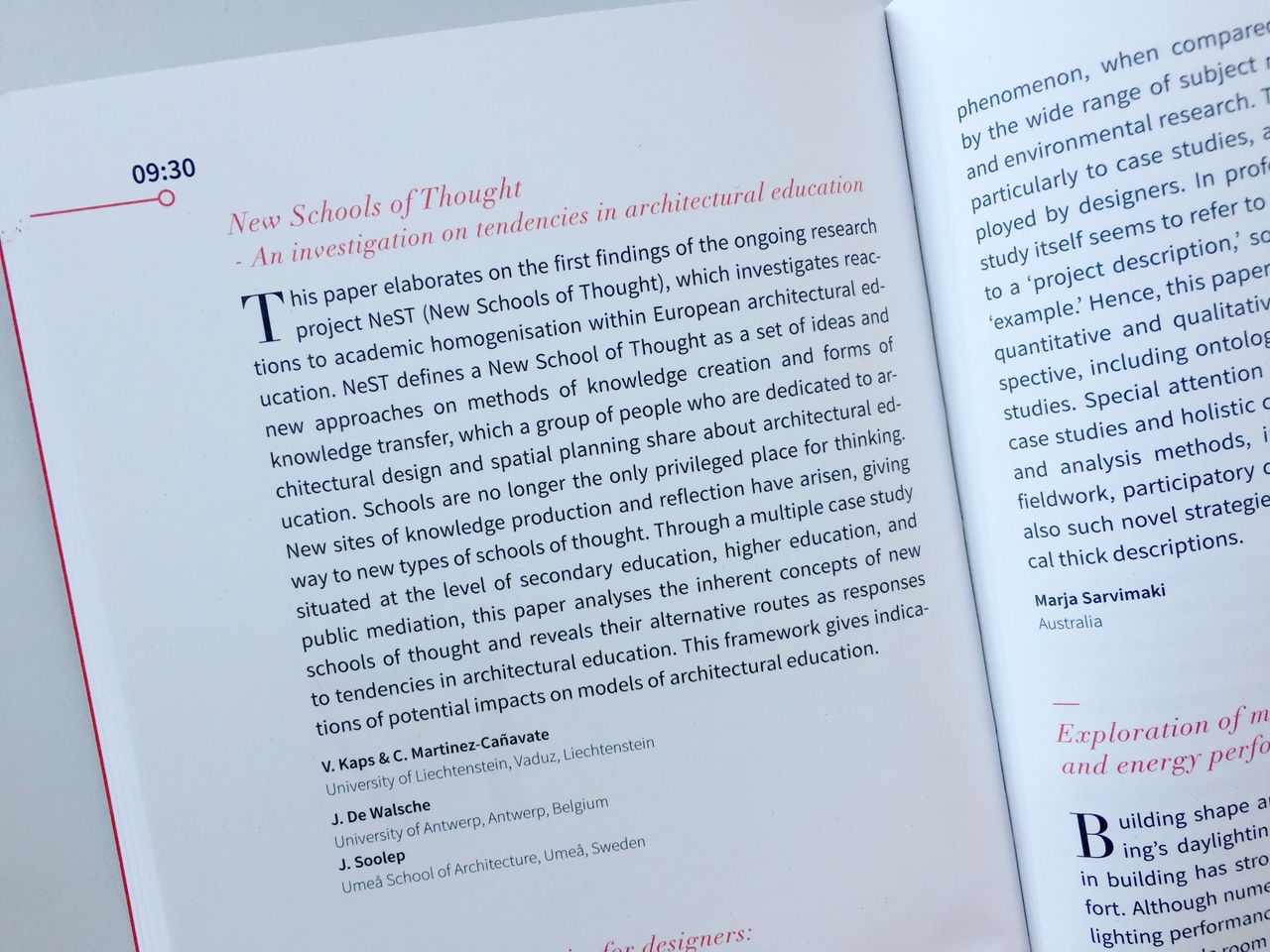 EAAE / ARCC 10th International Conference on Architectural Research addressing Societal Challenges
EAAE / ARCC 10th International Conference on Architectural Research addressing Societal Challenges
15.-18. June 2016 in Lisbon, Portugal
Education in the discipline of Architecture has evolved, mirroring societal challenges and conditions. Architectural Education can also be considered as a multitude of traditions with different national flavors. New social challenges address architectural education. How can architectural education respond to the changing role of the architect? How should the ideal biotope for architectural education look like? How is it related to research or practice? Which didactics prepare students to take position and face future societal challenges? (Conference brief on the sub theme “Research on Architectural Education”)
Vera Kaps and Celina Martinez-Cañavate presented the paper “New Schools of Thought - An investigation on tendencies in architectural education”.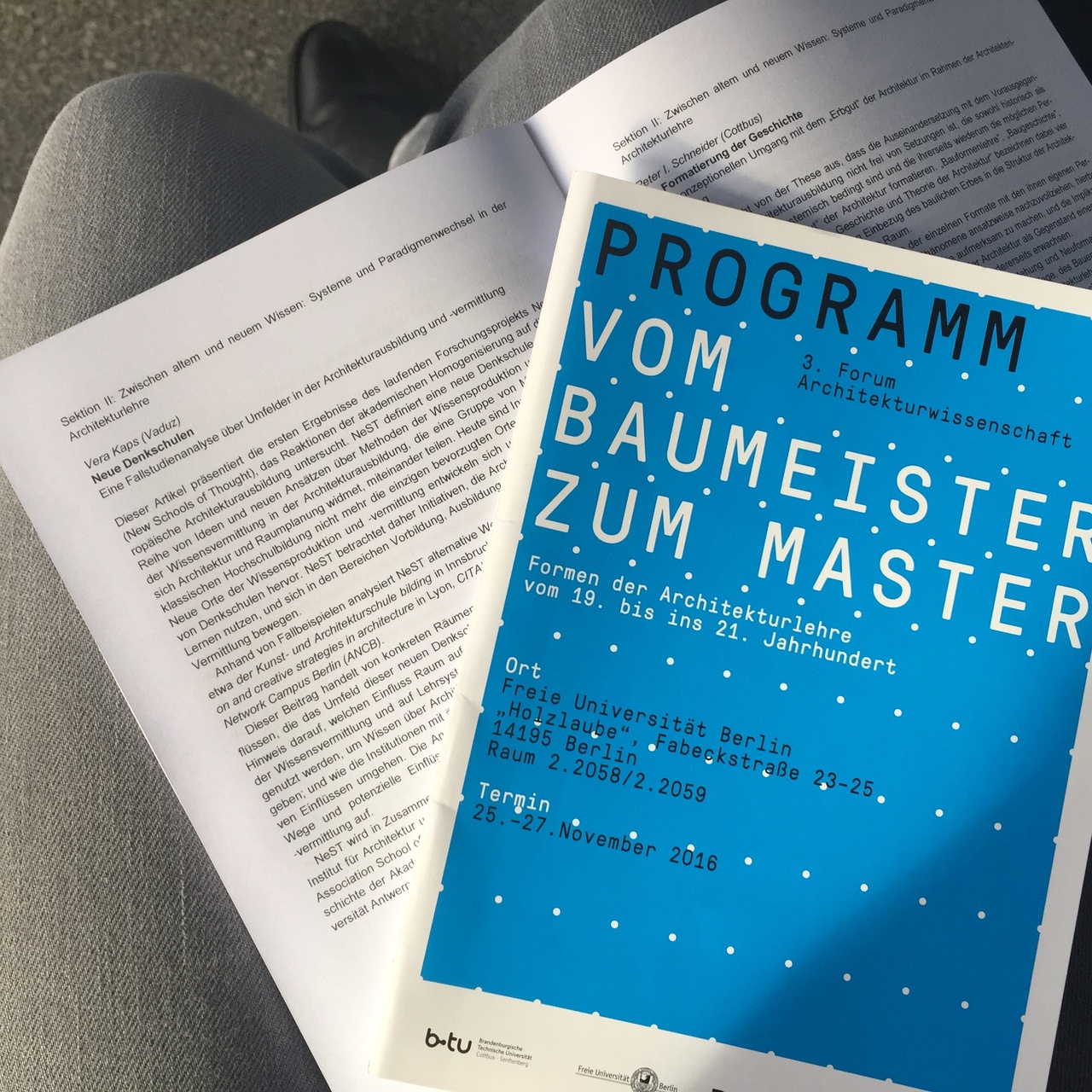 Netzwerk Architekturwissenschaft: Vom Baumeister zum Master ‐ Ideen und Impulse für die Architekturlehre des 21. Jh.
Netzwerk Architekturwissenschaft: Vom Baumeister zum Master ‐ Ideen und Impulse für die Architekturlehre des 21. Jh.
Architektur ist eine besondere Disziplin. Die Vielfalt ihrer Bezüge zwischen Kunst und Technik, Wissenschaft und Praxis macht nicht nur die Attraktivität des Studiums aus, sie stellt auch besondere Herausforderungen an die Lehre – didaktisch, inhaltlich und in der Zusammensetzung der Curricula. Während die Verfasstheit der modernen Architektur in den letzten Jahrzehnten vielfach Gegenstand einer Historisierung geworden ist, lässt sich dies für die moderne Architekturlehre nur eingeschränkt feststellen. Die Umstellungen des Bologna-Prozesses haben darüber hinaus in der vergangenen Dekade viel Energie für Akkreditierungs- und Modularisierungsdiskussionen benötigt – ein Prozess, in dem gelegentlich schon die Bewahrung des Bewährten als hehres Ziel gelten musste.
Das 3. Forum Architekturwissenschaft erstrebt eine interdisziplinäre wissenschaftliche Auseinandersetzung mit Lehrdispositiven und konkreten Formen der Architekturlehre vom 19. bis ins 21. Jahrhundert, um so einen Diskurs zu Geschichte, Gegenwart und Zukunft der Architekturlehre zu befördern. Zu drei Themenfeldern suchen wir historische Sichtweisen und systematische Perspektiven sowie Strategien, die einen Zukunftsentwurf für die Ausbildungen von Architektinnen und Architekten entwickeln. Neben Beiträgen aus der Architektur(-geschichte) sind auch Positionen aus der Soziologie, Didaktik, den Kulturwissenschaften etc. willkommen. www.architekturwissenschaft.net
Vera Kaps presented the paper “New Schools of Thought - A case study analysis on environments of architectural education” during the conference 25.-27. November 2016 in Berlin, Germany.
Studios
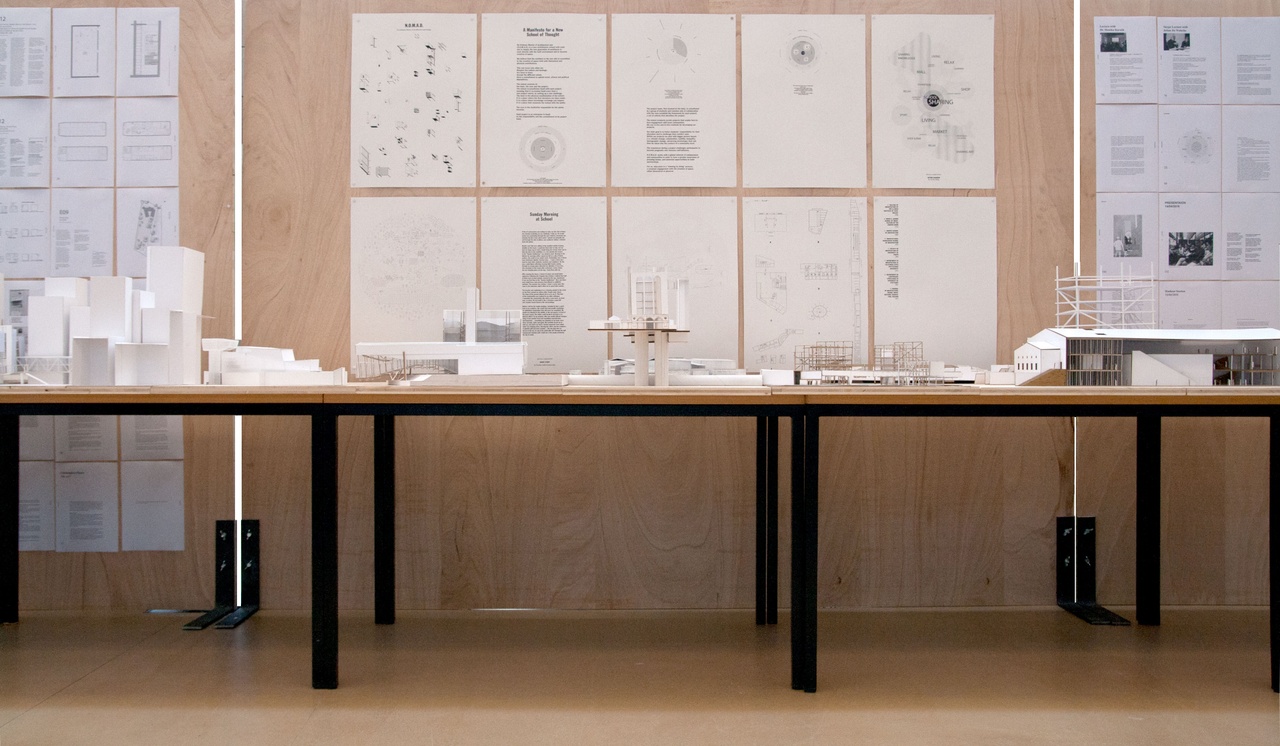 Master Studio Staub / Papathanasiou: New School of Thought
Master Studio Staub / Papathanasiou: New School of Thought
Universtiy of Liechtenstein, Summer Semester 2016
Studio Staub/ Papathanasiou focused on the design of new schools of thought, in close collaboration with institutions and individuals working on the ongoing research project with the same name, short «NeST».
They conceived and designed proposals for a new school of thought within the architectural realm. A digital archive of precedents served as a basis for the formulation of a common manifesto that the students produced for a new school of thought, taking a position on the current architectural scene/milieu and the contemporary system of architectural education. They speculated on what and how to learn, while simultaneously conceive, imagine and design spaces that emerged from their manifesto and their ideological conception of knowledge production. During the last half of the semester students developed and differentiated the common manifesto while produced individual spatial configurations for new schools of thought. By proposing spatial and syntactic structures, the projects manifest different forms of learning processes and mediation.
During the Design Seminar they traveled to London to experience new forms of architectural mediation as well as meeting and working with research partners and colleagues at the Architectural Association School of Architecture (AA), the Bartlett and the Royal College of Art among many other institutions.
The student’s work were included in a publication, event and performance part of the Salon Suisse 2016 on the opening day of the 15th International Architecture Exhibition, La Biennale, in Venice. Bachelor Studio Egg: Luftschloss
Bachelor Studio Egg: Luftschloss
Universtiy of Liechtenstein, Summer Semester 2016
Unser Studio gleicht einem Luftschloss im Sturm, der über eine Landschaft hinwegfegt. Der Sturm hat ein Anfang und ein Ende, während die Landschaft unendlich ist.
Gertrude Stein unterscheidet in «The Geographical History Of America»
zwischen der Natur des Menschen und seinem Geist. So steht die menschliche Natur für die Identität, die Institution, die Anlage, den Rahmen, das Messbare, die Historie, die Fertigkeit und eine begrenzte Zeit. Die Landschaft aber entspricht dem menschlichen Geist, sie ist unendlich. Sie absorbiert die Spuren des Sturms, sie ist unverwechselbar und frei.
Die Initialen unserer Schaffensprozesse vermuten wir im konstruktiven Prinzip. Die Wahrheitsfindung erschliesst sich bruchstückhaft aus Wissensfragmenten, die zu einem dreidimensionalem kognitiven Konstrukt heranwachsen und eine Erfinderlust wecken dieses Wissen in neue eigene Architekturen d.h. räumliche sowie formale Strategien zu überführen. Wir wollen Fertigkeiten erlangen, die sich der Referenzlosigkeit einer ausschliesslich digital generierten Welt entgegenstellen und das taktile Original mit-zelebrieren.
Materialtransfer aus der New York Expedition in ein Dokumentarisches Format, welches im Salon Suisse 2016 – am Eröffnungsanlass der 15. internationalen Architekturausstellung an der Biennale in Venedig – samt unserem erarbeiteten Studiokonzept / Manifesto publiziert und bekanntgemacht wird.
Wir gründen das Haus der Gedanken. Gemeinsam als Ateliergruppe setzen wir die Erkenntnisse der vorangegangen neun Wochen physisch um. Ein Modell und Zeichnungen komplementieren das Manifesto.
Lern(t)räume – ein Architekturworkshop der Universität Liechtenstein mit der Primarschule Vaduz Äule und der Realschule Balzers 2017
Im Rahmen des Architekturprojekts Lern(t)räume erforschte das Institut für Architektur und Raumentwicklung der Universität Liechtenstein gemeinsam mit zwei Schulen aus Liechtenstein experimentelle Lernräume ausserhalb des Klassenzimmers. Innerhalb der Workshops suchten die SchülerInnen innerhalb ihres Schulareals nach Räumen, die für verschiedene Lernbedürfnisse nutzbar sind. Die Schule wurde insofern neu definiert, als dass das gesamte Schulareal zum Lernraum erklärt wurde. Gesucht wurde nach Räumen/ Ecken/Orten der Kommunikation, des Rückzugs, des Austauschs, des Beobachtens, der Bewegung, der Information,. Auf diese Art standen nicht nur Klassenräume im Fokus unserer Aufmerksamkeit, sondern die scheinbar nebensächlichen und im Schulalltag untergenutzten
Räume. Über sieben Workshops entstanden Zeichnungen, Collagen und Texte, die Visionen von neuen Lernräumen beschreiben, und Lernlandschaften, die zu verschiedenen Formen des aktiven Lernens einladen: lesen, hören, diskutieren und ausprobieren. Die Projekte sind vom 31. März bis zum 20. April 2017 im Seitenlichtsaals des Kunstmuseums Liechtenstein zu erleben.
Team
Prof. Peter Staub, University of Liechtenstein
Prof. Peter Staub (1977, Zurich) is an architect and researcher in architecture and visual culture. He studied at the Accademia di Architettura di Mendrisio and graduated from the Architectural Association School of Architecture (AA Dipl 2003) and the Cities Programme at the London School of Economics (MSc 2008). He has been a Unit Master at the AA and has taught at the Ecole Polytechnique Fédérale de Lausanne and the University of Liechtenstein, where he holds the associate professorship in Architecture and Visual Culture and is the Academic Director of the Master’s degree programme in architecture. His main focus in teaching and research is on the mediation of architecture and building cultures. The results have been made public in a variety of exhibitions and publications, including in his books “Mediating Architecture” (with Theo Lorenz, AA Publications 2011) or “Raumkultur und Identität” (with Alberto Alessi and Andri Gerber, Niggli 2013).
Vera Kaps, University of Liechtenstein
Vera Kaps is an architect and researcher in architecture and spatial sociology, born in 1985. Educated at the University of Stuttgart in Germany and at the PUC (Pontificia Universidad de Chile) in Santiago de Chile, she graduated in Architecture and Urban Planning. Vera worked in Stuttgart-, Frankfurt-, Vienna- and Zurich- based offices in the fields of architecture, urban planning and exhibition design. She also works as a writer for the Berlin-based architectural magazine Bauwelt. Currently she is working as a research assistant at the Institute for Architecture and Planning at the University of Liechtenstein. In 2014 she started her PhD onBuilding identity where she investigates the creation of identities through social and physical spatial production on example of the Swiss National Exhibition. Her research focus is on the mediation of architecture with focus on exhibition formats and the construction of identities and borders.
Ekaterina Nagibina, University of Liechtenstein
Ekaterina Nagibina is an architect, with a background in photography, born and raised in Russia. She has a degree in Architecture from the Tyumen State University of Architecture and Civil Engineering and a Masters’ Degree in Architecture from the University of Liechtenstein. Ekaterina contributed to the exhibition Once upon a Time in Liechtenstein …, first official participation of Liechtenstein in the 14th Architectural Biennale in Venice in 2014, curated by Rem Koolhaas. Her photographs were used for the exhibition Fair Enough in the Russian Pavilion on the same Biennale. Currently she is working as a researcher at the University of Liechtenstein.
Celina Martinez, University of Liechtenstein
Celina is an architect, urban planner and researcher, born in 1977. Educated at the Escuela Tecnica Superior de Arquitectura (ETSAM) in Madrid and at the Architectural Association (AA) in London, she graduated in Interior Design, Architecture and holds a MA in Environmental Design. Celina worked in Madrid-, London- and Zürich- based offices in the fields of urban design. She led projects at KCAP architects & planners and at the Future Cities Laboratory, a joint research project between the ETH (Eidgenössische Technische Hochschule) in Zurich and the NRF (National Research Foundation) in Singapore. Currently she is working as a researcher and doctoral student at the Institute for Architecture and Planning at the University of Liechtenstein.
Dr. Christopher Pierce, Architectural Association London
Christopher Pierce completed his architecture studies at Virginia Tech and gained a PhD in architectural history at the University of Edinburgh. He has been teaching at the Architectural Association since 2007 as an Intermediate Unit Master, Lecturer in architectural history and theory and as Director of the AA’s Visiting School programme. He has published widely on seventeenth- and eighteenth-century drawings as well as writing critiques that cover a disparate range of contemporary architects and buildings, from Léon Krier to Ron Arad. Among his recent publications is an edited monograph – Ceramica Cumella: Shaping Ideas | Modelando Ideas – and essays on Herzog and de Meuron, ‘Sleep- er(s)’, AMID.Cero 9, 'Kisses' and Jordi Bonet Armengol, 'Gaudi's Gatekeeper'.
Ass. Prof. Johan de Walsche, University of Antwerp
Johan De Walsche is associate professor of architecture at the Faculty of Design Sciences at the University of Antwerp. His research interests focus on architectural research methodology, design research, architectural education and the research-teaching nexus in the architectural design studio. Further topics of interest include building culture in territories in transition, with e.g. graduate student projects in Cairo and Aswan, Egypt - in cooperation with the Ain Shams University Cairo - Paramaribo, Suriname, in cooperation with the Adekus University Paramaribo, and in Casablanca, Morocco. Johan De Walsche is founding member of ARENA, an international research network in architecture, where he is project leader of the research Seminars DR_SoM [Design Research, Series on Methods]. He is co-editor of the book “Theory by Design”, resulting from the conference with the same name. He was coordinator and penholder of the working group of the EAAE Charter on Architectural Research. He is member of the expert group of the ECOOM research project on the evaluation of artistic and designerly research outcome in Flanders, Belgium. Johan De Walsche has been member of the scientific committee of several conferences on architectural education, architectural research, and design research. He has been external examiner, visiting critic and keynote speaker for graduate students and PhD candidates at several schools.
Dr. Jüri Soolep, Umeå University
Jüri Soolep (1962) is Guest-Professor at Umeå School of Architecture, Sweden. He has been Rector of the Nordic Academy of Architecture – academic corporation of Nordic and Baltic schools of architecture. From 2001 to 2011 he was dean and professor of the Faculty of Architecture in the Estonian Academy of Arts. He received his Doctorate from Portsmouth University in 2001 with the dissertation On Realities and Horizons of Design in Architectural Education. He was involved in implementing the Architectural Policy of the Estonian Government and was member of the European Commission Advisory Committee on Training and Education in the Field of Architecture. He was also member of Architects’ Council of Europe work group on access to profession, accreditation and validation. He was leading the Nordic Academy of Architecture work group on educational quality and was the general editor of the report for the Nordic Council of Ministers: Nordic Dimension in Architectural Education: Working Towards Better Accreditation and Quality Assurance. Jüri Soolep has lectured in the universities of Tartu, Oulu, Porto, Cork, Portsmouth, Liverpool, and Hosei, Tokyo. Since 1991 he has been lead designer and partner in the architectural studio Archimedium. He is in the editorial board of journals Ehituskunst and ArchiDoct. He has been member of steering boards for Strong Research Environments ResArc and Making within Swedish Research Council Formas grant. His current field of interest include studies on the representational system of architectural phenomena in the age of digital imagosphere. His lectures on history of architecture deal with the archetypal structures, cultural patterns and political meanings.
Univ. Prof. Wolfgang Tschapeller, Academy of Fine Arts Vienna
Univ. Prof. Angelika Schnell, Academy of Fine Arts Vienna
Professor of architecture theory and architecture history at the Academy of Fine Arts Vienna. Study of Theatre Science and Architecture in Munich, Berlin and Delft. From 1993 until 2001 editor of the Berlin settled architectural magazin ARCH+. Since 1999 teaching positions in architectural history and architectural theory at several international universities. Awarded dissertation on the architecture theory of Aldo Rossi. Numerous essays in international magazines and books. Focal points: history and theory of modernism; modern architecture and urban planning in the 20th and 21st century; media and architecture; the notion of transparency; the relationship of postmodern architecture and theories to the arts, to literature, and psychoanalysis.
Partners
Architectural Association
Akademie der bildenden Künste
Umeå University School of Architecture
University of Antwerp











